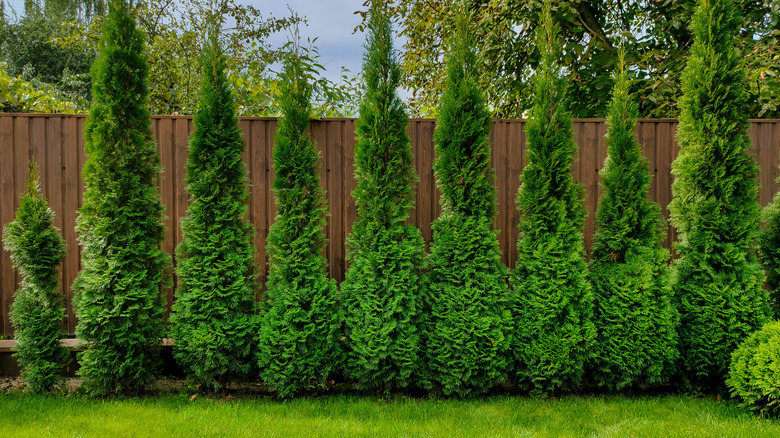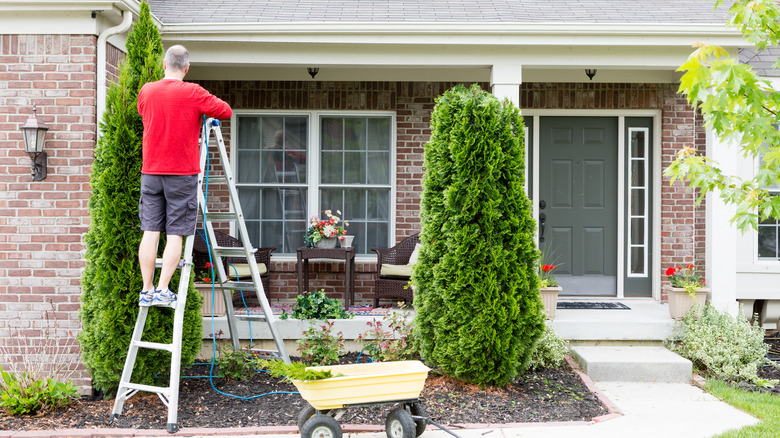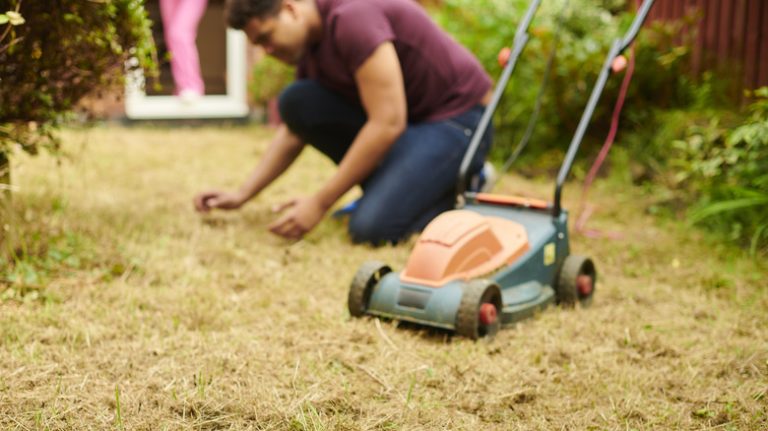Arborvitae’s (Thuja spp.) ornate, greenish-gold foliage has the hearts of plenty of homeowners, but you shouldn’t grow these plants next to your house. You’d think, as they grew, their younglings would retain their pyramidal, columnar, or conical shape (depending on the cultivar). However, these splendid conifers pack a surprise and love to spread out and gain height as they mature, crowding out the space. While this works spectacularly as a hedge or privacy screen, it can result in immense property damage when the fragrant, needle-like leaves brush against your home’s roof and walls.
Hardy between USDA hardiness zones 2 to 8, arborvitaes (or arbs) contain two American native species, American arborvitae (Thuja occidentalis) and Giant arborvitae (Thuja plicata). Both are popular choices for most homes subjected to HOA norms since these evergreen shrubs are easy to care for. They require proper drainage and sunlight and are an inexpensive way to block out unruly neighbors and traffic noise. Given that occidentalis can grow between 20 and 40 feet high and 10 to 15 feet wide, while the always-green plicata register a height of 50 to 70 feet and a width of 15 to 25 feet, planting them close to your abode is a recipe for disaster.
What makes arbs a bad call

Planting arborvitae shrubs close to the home is a bad call because gardeners often fail to account for their widening expanse. For instance, the ubiquitous Emerald Green variety grows 4 feet wide at maturity and must be distanced accordingly from the walls to avoid contact, irrespective of its nursery width. As these “trees of life” grow older, they struggle against the space, standing out of the building’s layout, marring the aesthetic. Plus, most cultivars grow pretty tall and, unless pruned regularly, pose a massive risk if placed underneath power lines, gutters, or overhanging roofs.
Moreover, if standing close to windows, their grown canopies block all scenery, and no matter how ornamental, there’s only so much verdure one can take. It works conversely when the walls begin shading the aromatic shrub, depriving it of the needed light exposure to exhibit healthy growth. The real trouble, however, begins when the spindly leaves retain water and stimulate mold and mildew growth along the wall siding while becoming home to pests. Some agile critters may even hop on their canopies to get indoors. Wall damage from broken clumps is a given, too.
Averting the disaster

Ideally, arborvitae plants are best used as natural fences and windbreaks far from the home’s foundation. However, if you insist on growing these resinous conifers close, ensure you space them at a distance equivalent to half of their mature width after checking for site suitability. Another alternative is to take stock of their maximum height and root them at three-quarters of the resultant measure. Usually, American arborvitae are planted around 8 to 10 feet away, as opposed to 9 to 11 feet away for Giant arborvitae species — although these numbers will vary depending on the ultimate variety. Plant them in zig-zag patterns rather than straight rows for added density.
Regular thinning of the canopies is essential when arbs adjoin the main walls, as it minimizes contact and takes care of any dead or diseased foliage. It also promotes open airflow, reducing susceptibility to fungal diseases. In cases of pruning irregularities, you may have to opt for renewal pruning, where the shrubs are cut down to 6 to 12 inches above ground. Unfortunately, arborvitae have a hard time recovering from such severe trimming. To avoid the risk, transplant them instead.



